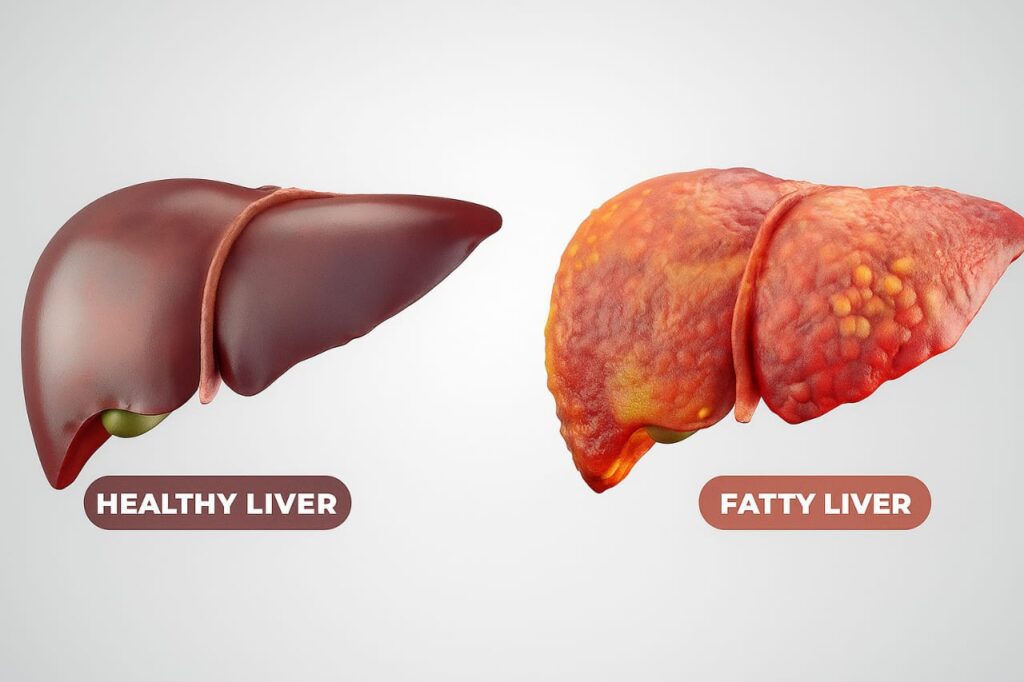Fatty liver disease has become one of the most common lifestyle diseases, affecting over a quarter of the world’s population. Unlike other chronic conditions, it is largely reversible. The proven lifestyle changes can not only manage but also reverse the condition in its early stages. We will break down the exact dietary shifts that reduce liver fat.
The liver is an essential organ of the body located in the upper right of the abdomen beneath the rib cage. It performs important body functions such as removing toxic or foreign substances from the bloodstream, creating essential nutrients, and regulating blood sugar levels.
Table of Contents
What is fatty liver disease?
Fatty liver disease occurs when fat builds up in more than 5% of the total weight of your liver. Over time, it can lead to scarring (cirrhosis).
There are two main types of fatty liver disease:
Alcoholic fatty liver disease
It is caused by drinking too much alcohol. During the process of alcohol breakdown in the body, some toxic substances are released, which damage the liver. In doing so, fat deposits over the liver, causing a fatty liver.
Non-alcoholic fatty liver disease (NAFLD)
It is the most common chronic liver condition unrelated to alcohol intake, which is also called metabolic-associated fatty liver disease (MAFLD), caused by fat deposits over the liver along with inflammation, damaging the liver.

Symptoms
Usually, fatty liver disease does not show symptoms, but people may have the following symptoms:
- Generally feel unwell or tired
- Lose weight
- Pain in the upper right of the abdomen
Signs that you might have a serious condition
- Dark urine or motion
- Blood vomits
- Swollen abdomen
- Jaundice (yellow eyes and skin)
- Itchy skin
Causes & risk factors
- Type 2 diabetes (insulin resistance)
- High cholesterol
- Overweight or obese, especially around the abdomen.
- Sedentary lifestyle (long-term sitting due to work)
- Drinking too much alcohol
- PCOS in women
Preventive measures
According to the Centers for Disease Control and Prevention, you can prevent, manage, or even reverse the condition of many non-communicable diseases. with lifestyle modifications, including:
Maintain a Healthy Weight
The top priority you should give to your body weight. Because Obesity is the leading risk factor for fatty liver disease. Losing even 5 to 10% of body weight can reduce liver fat.
Limit Alcoholic Intake
Alcohol is the primary factor that is toxic to liver cells. Even moderate alcohol intake can worsen fatty liver. The best choice is to avoid alcohol completely to prevent this disease.
Manage Diabetes and Cholesterol
Keep your blood sugar levels in control through a healthy diet, exercise, and medication if needed. Regular monitoring of cholesterol and triglyceride levels is most important to prevent further liver damage.
Adopt a Balanced Diet
Eat plenty of fresh fruits, green vegetables, and whole grains. Limit refined sugars, oils, and fried food. Lean proteins like fish, chicken, or legumes should be included in your diet. Eat healthy fats like olive oil and dry nuts instead of saturated fats.
Regular Exercise
Regular physical activity helps burn fat and improve insulin sensitivity. Hence, aim for at least 150 minutes of moderate exercise per week, like brisk walking, cycling, and swimming.
Conclusion
Fatty liver disease is a growing health concern globally. But it is largely preventable and even reversible. By adopting healthy lifestyle choices and avoiding alcohol, you can protect your liver. Remember, your liver possesses a powerful and natural ability to regenerate. By removing the sources of stress, added sugars, unhealthy fats, and sedentary habits, you create the ideal condition for your body to heal itself. The liver is one of the body’s most vital organs, and taking care of it today will ensure a healthier tomorrow.

